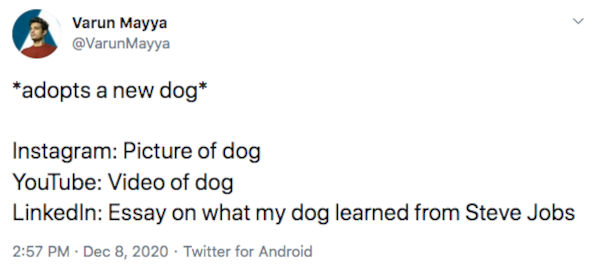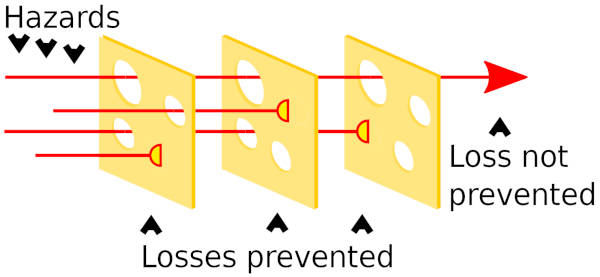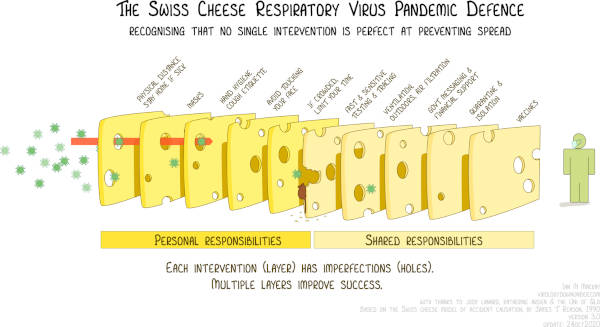[Image by Firmbee from Pixabay]
Dear friend,
Welcome to the latest edition of This Week in Disruptive Tech, a newsletter that explores the intersection between tech, business and society. This week we look at how these three events and ideas are revealing: Salesforce buying Slack; Google AI-ethics researcher Timnit Gebru getting fired; and the Swiss cheese model to fight Covid-19. Plus some interesting numbers, tidbits and perspectives that say something about what happens when tech meets the real world.
If you have suggestions, feedback, tips—or anything that you would like me to share in the newsletter—mail me at ramnath@foundingfuel.com or DM me on Twitter at @rmnth. If you haven't subscribed already, you can subscribe here.
Happy reading!
NS Ramnath
The Age of Disruptive Imitation
What’s the news? Salesforce.com, a CRM giant and cloud computing pioneer, said it’s buying Slack Technologies, a workplace communications platform, for $27.7 billion. Marc Benioff, Salesforce co-founder and CEO, called it “a match made in heaven”. Salesforce can now bundle Slack with its CRM offerings, just as Microsoft bundled Teams with Office 360, pushing Slack's market value down by 40% since its IPO, and an eventual sale.
Why should you care? In the world of business, especially technology business, we love to tell the story of the rise of the underdog. In 1995, Clayton Christensen explained that process through ‘disruptive innovation’—how new players with fewer resources successfully challenge established incumbent businesses.
He said, the incumbent businesses tend to focus on the most profitable segments, ignoring the lower-end customers. They become the first customers for the new entrants. The new entrants get better over time and compete for the high-end customers, with a different set of strengths that the incumbents don’t have. When their highly profitable customers move their business to the new entrants, the incumbents realise that they have been disrupted.
In 2016, when Microsoft decided to launch Teams as a rival product to Slack, Slack had 4 million users. Over the next four years, Slack grew threefold to 12 million users. However, by that time, Microsoft had grown from zero to 115 million users.
How did Microsoft do that? It copied Slack's basic design, and bundled it with its hugely popular Office 365. Slack, which once nurtured ambitions of becoming a tech giant, is now a part of Salesforce.
The episode also highlights the difficulty in defining terms like ‘incumbents’ and ‘new entrants’ in the world of technology (Was Microsoft a new entrant, and Slack an incumbent?), a point that tech giants generously use to wriggle out of inconvenient questions on monopoly power.
There’s another company that tried Microsoft's tack closer home. Reliance Jio copy-pasted the basic design of the Zoom app for its Jio Meet. Zoom is estimated to have about 35 million-40 million users in India. Jio has about 400 million subscribers. It’s not clear how many are using Jio Meet now, but that's one number that will be keenly watched in the coming months.
Dig Deeper
- Salesforce buys Slack in a $27.7B megadeal - Techcrunch
- What Is Disruptive Innovation? - HBR
Data Bites
20: India's rank in The Global AI Index. The US, China and the UK are the top three countries in the list. Two places below India: Saudi Arabia. (Tortoise)
$5.5 billion: PhonePe's valuation after it raised $700 million from Walmart, becoming the first UPI unicorn. (ET)
220 kmph: The speed at which Romain Grosjean’s Formula1 racing car slammed into a wall before going up in flames. Grosjean survived. Here's how. (Wired)
The Monstrous Moral Hybrid

[Image by Tumisu from Pixabay]
What's the news? Timnit Gebru, a Google AI-ethics researcher, said she was fired from the company after a fight over an academic paper she co-wrote with six others, including four other Google employees for a conference next year. Google wanted her to retract the paper, or at least remove the names of Google employees.
Why should you care? While the reasons for her ouster go beyond the paper—some accounts suggest gender and diversity issues (+ a thread by Gebru)—it highlights the inherent conflicts in some relationships.
In Systems of Survival, Jane Jacobs argues that two distinct sets of moral values underpin politics and commerce.
- One set is the “guardian syndrome”, interrelated principles that exhort its practitioners to shun trading, exert prowess, be obedient and disciplined, adhere to tradition, respect hierarchy and so on.
- The other set is “commercial syndrome”, again, interrelated principles demanding that its adherents shun force, compete, be efficient, be open to inventiveness and novelty, etc.
Jacobs said, bringing these two worlds together often results in 'monstrous moral hybrids' because of the very different morals that drive them, however, in some cases, they manage it through ‘knowledgeable flexibility.’
We saw some of the knowledgeable flexibility during the creation of Aadhaar, India's digital identity project, which brought the government and private sector together. But it also led to conflicts, that Charles Assisi and I documented in The Aadhaar Effect. As the project moved from ‘application development’ to the maintenance phase, there was no need for this hybrid. It went through a phase of bureaucratic capture, and is now a government body.
Just as there is an inherent conflict between commerce and politics, there's an inherent conflict between commerce and academia arising from the distinct moral values that underpin the two domains. The crucial difference between the two is academic freedom. While businesses like the prestige that comes from using jargons from academia—Apple University, Google Scholars, IBM Fellows—they draw a line around ‘shareholder value’.
The episode highlights that inevitable conflict. How will it resolve?
In a LinkedIn post Azeem Azhar, who runs Exponential View, suggests that, instead of employing researchers, Google can endow an independent research group, “with sandbox access to data from the firm, which can be staffed by a diverse set of researchers”.
Dig Deeper
- The Essential Ethical Quandary of Industry LinkedIn
- Behind the Paper That Led to a Google Researcher’s Firing Wired
Tweet of the Week

(https://twitter.com/VarunMayya/status/1336240904152051713)
The Swiss Cheese Model to Fight Covid-19

[Image by Marcos Cola from Pixabay]
What's the news? Tal Zaks, chief medical officer of Moderna, the second firm to announce that their vaccines have 95% efficacy rate, told Axios that the results “do not show that they prevent you from potentially carrying this virus...and infecting others.”
Why should you care? Even if you are vaccinated, you might still need to wear a mask. (Further studies might reveal that’s not the case, but right now, it looks like it’s best to go by the principle, better safe than sorry).
If the pandemic taught us one thing, it is the idea that layering multiple imperfect protections might keep us safe. We all know that physical distancing alone is not enough, masks alone are not enough, washing our hands alone is not enough, contact tracing apps alone are not enough. But when we combine all of these, we can pretty much be safe.
However, there is also a feeling that a vaccine will obviate the need for all the other measures, and take us back to pre-pandemic times (even while retaining some of the good that came out of these times as we adjusted to the new normal).
In a WSJ piece last month, Yale professor Nicholas Christakis pointed to the “Swiss cheese model”. He wrote: The British psychologist James Reason introduced the model more than three decades ago to discuss failures in complex systems such as nuclear power, commercial aviation and medical care. As Prof. Reason argued, “In an ideal world each defensive layer would be intact. In reality, however, they are more like slices of Swiss cheese, having many holes…. The presence of holes in any one ‘slice’ does not normally cause a bad outcome. Usually, this can happen only when the holes in many layers…line up…bringing hazards into damaging contact with victims.”

[Ben Aveling, Wikipedia]
The New York Times points out that Ian M. Mackay, a virologist at the University of Queensland, in Brisbane, Australia, has customised the Swiss cheese for the present pandemic.

“This multilayered approach to reducing risk is used in many industries, especially those where failure could be catastrophic. Death is catastrophic to families, and for loved ones, so I thought Professor Reason’s approach fit in very well during the circulation of a brand-new, occasionally hidden, sometimes severe and occasionally deadly respiratory virus,” Mackay told the newspaper.
Dig Deeper
- How the Swiss Cheese Model Can Help Us Beat Covid-19 (WSJ)
- The Swiss Cheese Model of Pandemic Defense (NY Times)
Quick Bites
- "When art critics get together they talk about Form and Structure and Meaning. When artists get together they talk about where you can buy cheap turpentine." (Picasso) When astronauts get together, what do they talk? This gives some hint: Nasa, the US space agency, has joined hands with Procter Gamble to make a laundry detergent for space.(New Scientist)
- Last year, Google said its quantum computer performed a calculation that would be impossible for a classical machine, achieving what's called quantum supremacy. IBM quickly countered the claim. Now, a year later, Chinese researchers say they have performed a computation mathematically proven to be impossible on normal computers. (Nature)
- Coronavirus pandemic is forcing us to look at everything with a fresh eyes. It turns out that scientists are spraying saliva-like droplets in the Netherlands’ largest football stadium. Their goal is to find out how a crowd might spread aerosols through the air, and use the information to remove them from air. (Reuters)

